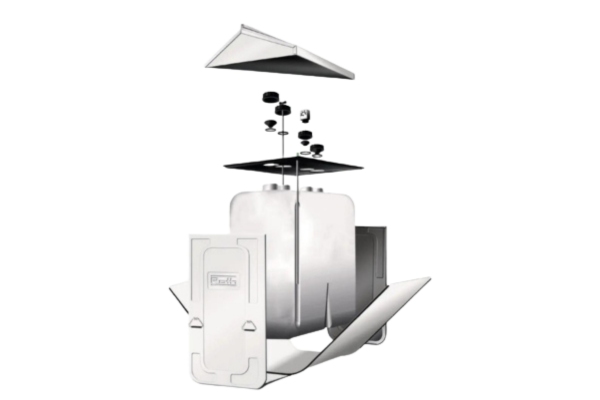Table of Contents
- The Progression of Heating Oil Tank Design
- Early Heating Oil Tank Designs and Their Limitations
- Recent Advancements in Fuel Oil Tank Design
- Examples of Modern Heating Oil Tank Designs
- Technological Innovations Shaping Heating Oil Storage Design
- Ongoing Challenges and Future Prospects
- Frequently Asked Questions About Oil Tank Replacement
- How Can I Tell If My Heating Oil Tank Requires Replacing?
- How Frequently Should Heating Oil Storage Tanks Be Inspected?
- Can Fuel Oil Tanks Be Recycled or Disposed of Responsibly?
- How Does Location Affect the Choice of an Oil Tank?
- Are Tax Incentives or Rebates Available for Upgrading to Modern Heating Oil Tanks?
- In Conclusion
- Rely on Lake Region Energy for Expert Home Comfort Solutions
Heating oil tanks have long been essential to heating systems in both homes and businesses, providing a reliable and cost-effective heat source. Over the years, advancements in technology have greatly enhanced the design and safety features of these tanks.
This progress plays a critical role in improving efficiency, promoting environmental sustainability, and ensuring the safety of users and their communities. In this article, Lake Region Energy, a reliable provider of heating oil delivery services, explores the latest innovations in heating oil storage tank design.
Get the Best in Heating Oil Delivery: Contact Lake Region Energy for reliable service and expert oil tank replacements. Contact us today!
The Progression of Heating Oil Tank Design

To fully appreciate the impact of modern innovations, it’s important to understand the development of heating oil tanks over time. Early heating oil tanks were basic in design, typically constructed from steel and installed above or below ground.
These tanks, which continue to be used today, serve the primary function of storing heating oil for residential and commercial buildings. They provide fuel to furnaces or boilers that generate heat, ensuring the comfort of the space.
Choose Quality Service: Call Lake Region Energy for trustworthy heating oil delivery and expert oil tank replacements! Call us now!
Early Heating Oil Tank Designs and Their Limitations
The first heating oil tanks were made of single-walled steel. Although they effectively stored and delivered oil, they developed several noticeable flaws over time. Steel tanks were susceptible to rust and corrosion, which increased the risk of leaks. These leaks resulted in wasted oil, higher costs, and significant environmental hazards.
Additionally, identifying leaks in these early tanks was often challenging, with issues typically going unnoticed until they caused considerable damage.
Underground heating oil tanks introduced additional complications. Over time, they were exposed to significant wear and tear from surrounding soil and groundwater, which sped up the corrosion process. Furthermore, detecting leaks in underground tanks was even more difficult, heightening the risk of soil and groundwater contamination spreading before the issue could be detected and addressed.
Recent Advancements in Fuel Oil Tank Design

Acknowledging the flaws of traditional heating oil tanks, industry leaders focused on creating designs that would overcome these challenges. A notable advancement was the development of double-walled tanks. This design includes an inner tank for storing oil, while the outer tank acts as a secondary barrier, containing any oil that escapes from the inner tank. This innovation offers enhanced environmental protection and reduces the risk of leaks.
Along with structural improvements, the use of new materials in heating oil tank construction has contributed to better durability and safety. Fiberglass, for example, gained popularity due to its resistance to corrosion, offering a longer-lasting and more reliable option for oil storage.
Boost Your Heating Efficiency: Contact Lake Region Energy for top-notch heating oil services and advanced tank installations! Call now!
Examples of Modern Heating Oil Tank Designs
Contemporary heating oil tanks integrate these advancements to offer safer and longer-lasting solutions. A good example is the Roth Double-Walled Oil Storage Tank, which has a steel inner tank for added durability and a corrosion-resistant outer tank for greater safety.
The outer tank also has an oil monitor that detects leaks early, reducing environmental risks. Another example is the Granby 2-in-1 Fiberglass Oil Tank, which combines the strength of fiberglass with a modern double-wall construction for superior performance.
The development of a heating oil tank design highlights the industry’s commitment to overcoming the limitations of earlier models, especially regarding safety and environmental impact. With ongoing technological advancements, we can anticipate even more improvements in this area in the future.
Technological Innovations Shaping Heating Oil Storage Design

Continue reading to learn how technological advancements are transforming oil tank designs.
Advancements in Materials and Manufacturing Techniques
The introduction of advanced materials and enhanced manufacturing methods has significantly transformed the heating oil tank industry. Materials like fiberglass and polyethylene, known for their corrosion resistance, have greatly extended the lifespan of tanks. Additionally, improved welding techniques and modern manufacturing processes have resulted in stronger, more leak-proof tank designs.
Optimize Your Energy Efficiency: Reach out to Lake Region Energy for top-quality heating oil delivery and effective oil tank upgrades! Call now!
The Role of AI and IoT in Managing Heating Oil Tanks
Innovations like artificial intelligence (AI) and the Internet of Things (IoT) have been key in advancing heating oil tank design. These technologies enable remote monitoring of oil levels and the overall condition of tanks, supporting predictive maintenance and early identification of potential problems.
Sustainable Designs for Lower Environmental Impact
The increasing emphasis on sustainability has pushed the creation of eco-friendly tank designs. These include tanks made from recyclable materials and designs that aim to prevent common issues faced by users of oil-based heating systems.
Advancements in Heating Oil Tank Safety

- Safety Concerns with Traditional Oil Tanks: Older heating oil tanks, especially those constructed from steel, have long posed safety risks. These include the possibility of leaks, which can lead to environmental damage, fire hazards, and health threats to individuals nearby.
- Improvements in Safety Features and Regulations: Modern heating oil tank designs have incorporated advanced safety features to address these concerns. These include double-wall structures and integrated leak detectors. Furthermore, regulations now require regular inspections and compliance with strict design and installation standards to ensure greater safety.
- The Impact of Sensor Technology on Heating Oil Tank Safety: Sensor technology is vital in enhancing the safety of heating oil tanks. These sensors are capable of monitoring oil levels, detecting leaks, and sending alerts when maintenance is needed. This boosts safety and the tank’s efficiency and lifespan.
- Examples of Safety Innovations: Leading manufacturers in the heating oil tank industry have pioneered safety innovations. For example, Roth’s safety oil tanks have a double-wall design and a leak monitoring system. Similarly, Granby’s EcoGard tank boasts durable construction and a high-tech coating that resists corrosion.
Choose Reliability: Contact Lake Region Energy for trusted heating oil delivery and professional oil tank replacement services! Call now!
The Effect of Design and Safety Innovations
- Cost Savings and Enhanced Efficiency: The latest design and safety innovations in heating oil tanks lead to substantial cost savings and greater efficiency. Tanks made from stronger materials last longer, reducing the need for replacements. Furthermore, remote monitoring and maintenance through AI and IoT technologies help prevent costly leaks and system failures.
- Environmental Benefits: The most notable environmental advantage of these innovations is the reduced risk of oil spills and leaks. This safeguards soil and groundwater from contamination, preserving the health of local ecosystems.
- Health Benefits: Advanced safety features and leak detection technologies help safeguard the health of individuals and communities by minimizing exposure to oil leaks and the fire hazards they may cause.
Ongoing Challenges and Future Prospects

Although there has been substantial progress, challenges remain in adopting new designs and safety features. These challenges include the high cost of emerging technologies and the need for broader implementation of regulatory standards.
Looking ahead, we can expect continued advancements in the field. This may include integrating more sophisticated AI and IoT technologies, creating even more durable materials, and placing a greater emphasis on adopting eco-friendly designs.
The future of the safety and design of heating oil tanks is bright, with technology driving ongoing improvements in efficiency, safety, and environmental sustainability. Continuous research and development are poised to bring even more innovative solutions to the industry.
Trust the Experts: Contact Lake Region Energy for dependable heating oil delivery and professional oil tank installations! Call now!
Frequently Asked Questions About Oil Tank Replacement

How Can I Tell If My Heating Oil Tank Requires Replacing?
A few signs that your heating oil tank may need replacement include visible rust, corrosion, or dents, and oil odors or wet spots around the tank, which could indicate leaks. A sudden drop in oil levels may also suggest a leak or structural problem. Tanks older than 20 years are more susceptible to these issues and should be considered for replacement with newer, safer, and more efficient models.
How Frequently Should Heating Oil Storage Tanks Be Inspected?
Heating oil tanks should undergo professional inspections at least once a year to detect potential issues, such as leaks, corrosion, or structural damage. These inspections help ensure the tank operates safely and efficiently while adhering to local safety regulations. Regular inspections extend the tank’s lifespan and help prevent expensive repairs and environmental risks.
Can Fuel Oil Tanks Be Recycled or Disposed of Responsibly?
Yes, heating oil tanks can often be recycled, especially those made from recyclable materials like fiberglass or polyethylene. Proper disposal requires draining any remaining oil, cleaning the tank, and following local environmental guidelines for handling hazardous materials. Many manufacturers or service providers support recycling and safe disposal to ensure compliance and minimize ecological impact.
Rely on Lake Region Energy to Keep You Comfortable: Dependable Heating Oil Services and Professional Tank Replacements! Call now!
How Does Location Affect the Choice of an Oil Tank?
Location is significant when selecting the right oil tank. Aboveground tanks are easier to maintain and inspect, making them ideal for residential use. Underground tanks, while requiring more durable, corrosion-resistant materials to handle soil pressure and moisture, save space and are less noticeable. The choice should consider practical needs, aesthetic preferences, and environmental factors, with advice from a professional.
Are Tax Incentives or Rebates Available for Upgrading to Modern Heating Oil Tanks?
Various regions provide tax incentives, rebates, or financial assistance for upgrading to modern, eco-friendly heating oil tanks. These programs promote the use of safer, more sustainable designs, such as double-walled or fiberglass tanks, which help reduce environmental risks. To make the most of these savings, homeowners and businesses should explore local programs or consult experts knowledgeable about energy efficiency and regulatory requirements.
In Conclusion
The progression of heating oil tank design and safety demonstrates an ongoing effort to improve this essential industry. Adopting cutting-edge technologies, new materials, and environmentally friendly designs has already made a considerable difference, and the possibilities for further advancements are extensive. Ongoing innovation is crucial for promoting safe and sustainable heating oil usage.
Choose Quality: Rely on Lake Region Energy for top-tier heating oil services and smooth oil tank replacements!
Rely on Lake Region Energy for Expert Home Comfort Solutions
Lake Region Energy is dedicated to providing top-notch heating oil services to residential and commercial clients throughout Maine and New Hampshire. We focus on prompt and efficient delivery to keep your space warm and welcoming. Our commitment to excellence is reflected in our competitive rates and clear communication, always prioritizing your satisfaction.
By choosing Lake Region Energy, you’re partnering with a trusted provider known for outstanding service and a strong focus on customer satisfaction. Whether it’s the peak of winter or a cool fall evening, we’re here to fulfill your heating needs and maintain a comfortable home year-round.
In addition to our heating oil services, Lake Region Energy offers various HVAC services to ensure your systems run smoothly. From regular tune-ups to emergency repairs and new installations, our team of certified HVAC technicians delivers expert service tailored to your needs.
Count on Lake Region Energy to fuel your home and enhance your heating and cooling systems for optimal performance. Contact us today to begin your service and experience the Lake Region Energy difference!
For more information about our fuel deliveries and HVAC services, be sure to contact Lake Region Energy. You can click here to contact us, or you can call us at (207) 839-5500 to find out more. Click the link to view our service area.

Related Articles:
- The Sludge Problem: What’s Inside Your Heating Oil Tank?
- The Science Of Heating Oil: Why It’s A Smart Choice For Your Home
- Heating Oil Additives Explained: Benefits & Uses
- Why Regular Heating Oil Filter Changes Are Essential For Your System
- Understanding the Factors Behind Heating Oil Price Fluctuations
